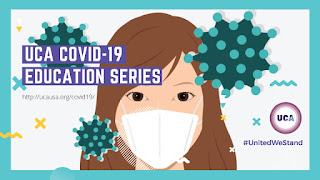2: What to do if someone is sick in my family?
Q: What should I do if someone is
sick in my family?
💁Tracy: If a member of your
family has mild symptoms, such as low-grade fever, mild dry cough and mild
fatigue, don’t panic! Please refer to What
can I do if I am sick to help the
sick member.
Here is what to do for the whole family,
please refer to CDC's guideline here. The following are
a few tips:
l Place the patient in
a well-ventilated “isolation” room (see note).
Note: Scientists are
studying if and how COVID-19 spreads through central AC. Isolation room ideally should have its own window for air
circulation and please avoid using central AC before conclusive
recommendations are given by CDC.
l Assign one person in
a good health to take care of the patient wearing personal protective
equipment, such as respirator and gloves.
l Follow doctor’s
instructions for medication(s) and care of the patient.
l Everyone in the
family should perform hand hygiene frequently.
l Clean all
“high-touch” surfaces, such as counters, tabletops, doorknobs, bathroom
fixtures, toilets, phones, keyboards, tablets, and bedside tables, every day.
l Wash laundry
thoroughly.
l Place all used
disposable gloves, facemasks, and other contaminated items in a lined container
before disposing of them with other household waste.
l Monitor everyone's
health. If anyone develops COVID-like symptoms, call your healthcare provider
immediately.
Facts and Tips
Simple
facts about COVID-19
COVID-19 is thought to spread mainly through close contact from person-to-person in respiratory droplets from someone who is infected. To minimize the chance of infection, separate food, utensils, and other personal items from those who are infected. Always wash your hands with soap and water for 20 seconds before eating food.
|
Tracy’s Toolbox
Equipment you need:
ü 70%
Alcohol or other types of disinfecting liquid/spray/wipes,
ü disposable
gloves,
ü protective
clothing (plastic aprons or disposable raincoat),
ü medical
masks.
|
💁Tracy’s
Tips on what to do to protect the whole family when a member of the family
is sick:
- No visitors to the patient’s room other than the caretaker.
- Separate all personal items between patient and others. Do not touch patient’s items unless they have been thoroughly disinfected.
- The patient should cover his/her cough and sneezes, especially when anyone else is in the same room.
- The patient should get rest and stay hydrated.
- Limit the movement of the patient and minimize shared space. Ensure that shared spaces (e.g. kitchen, bathroom) are frequently disinfected and well ventilated (e.g. keep windows open). The patient should use a separate bathroom, if available.
- The patient should eat alone in his/her own room, and the utensils should be disinfected thoroughly.
- The patient should remain at home until the symptoms are resolved for at least 3 days.
- Wash hands following all contact with ill persons or their immediate environment.
- Use disposable gloves and protective clothing (e.g. plastic aprons) when cleaning or handling surfaces, clothing or linen soiled with body fluids. Wash hands before and after removing gloves.
- Wash the patient's clothes, bedclothes, bath and hand towels, etc. at 140-194 ℉, and dry thoroughly.
References
Writing: Jingyi Xi, et al, Translation: Jingyi Xi, et al, Scientific Editing: Helen Shih Artwork: PotterW











